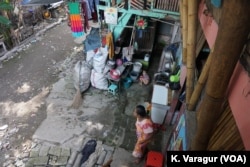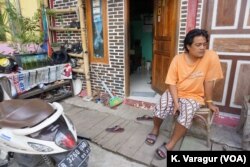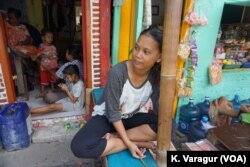The tight-knit neighborhoods, or kampungs, of North Jakarta that fan out from the city's historic old harbor and abut the toxic Ciliwung River have long been a lightning rod for issues of land rights, social class, and politics.
Residents have been subject to evictions for at least two decades as city officials have tried, mostly unsuccessfully, to redevelop the area for business or tourism. The neighborhoods are also in the part of the city that is most susceptible to floods and sinking.
Although evictions have temporarily stopped during the administration of Jakarta governor Anies Baswedan, the question remains whether people should live there at all, when the northern parts of the city are sinking so fast. Are the riverside kampungs simply doomed?
One young Indonesian architect doesn't think so. Kamil Muhammad, 32 years old and based in Jakarta, designed a sustainable model home in Kampung Tongkol that has been housing seven families for two years as of January 2018.
As part of Architecture Sans Frontieres Indonesia, Muhammad oversaw the construction of a three-story home built of brick and bamboo that overlooks a branch of the Ciliwung. Residents of the community helped to build and paint it. It's a unique structure, but Muhammad sees it as a template for other innovative housing in these neighborhoods, which he says need not be just preserved or saved, but also improved and beautified.
A model home
Tongkol resident and civil society activist Gugun Muhammad approached Kamil Muhammad (no relation) in 2015 with the idea to brainstorm a better kampung home. They met during a community mapping project called "Peta Jakarta."
"We came here to build a pilot house but then realized there were bigger issues at play," said Kamil Muhammad. "Trying to avert evictions quickly took over."
Everyone in Tongkol had already abruptly "trimmed" their houses five meters from the street because of a sudden regulation related to flood prevention. Even today, tiles can be seen up and down the main road in Tongkol that suddenly cut off mid-design. Kamil Muhammad and his colleagues from the University of Indonesia organized community workshops and started mapping the kampung's assets.
"That's when we realized everyone wanted different things, but what bonded them was the idea of not getting evicted," Muhammad said.
This was during the administration of the controversial Jakarta governor Basuki "Ahok" Tjahaha Purnama, who tried to evict several kampungs in the area for tourism development, an issue that flared up during the 2017-18 gubernatorial election. The model home was built in three months with a grant from the Asian Coalition for Housing Rights.
There are benefits to preserving these riverside communities that go beyond preservation for its own sake. There are dozens of heritage Dutch colonial buildings in the area, which the kampung residents can help preserve.
"This is in line with cutting-edge conservation and heritage preservation," Muhammad said.
Residents of Tongkol have also taken control of their stretch of the river by installing their own septic tanks, so a sense of pride and ownership can have a cascade effect.
"You want to make sure communities are really living here, instead of it being an open-air museum," Muhammad said.
Gugun Muhammad, his wife (who grew up in the kampung), and his two children are one of the seven families who live there today.
"It's really excellent," he said. "It makes the whole neighborhood proud."
A community ecosystem
A kampung differs from a middle-class neighborhood because of the high degree of its residents' interdependence, Kamil Muhammad said.
"It's not about a place to sleep; it's an ecosystem. Middle-class people have very high social mobility; we make friends with whoever we want. In a kampung, you work and socialize with your immediate neighbors. So, the idea of architecture must be fundamentally different," he said.
The third story of the model home is made of bamboo, which is light and flexible. Kampung homes tend to be pressed up against each other, which helps them support each other but also requires a clever hand with materials.
On a recent sunny weekday, Subiana, now in her 50s, sold coffee from a riverside shop she has run for decades; Saidi, a three-decade Tongkol resident and retired cab driver, cast a watchful eye on the youngest kampung kids who were running up and down the street, not yet bound to the classroom; and Gugun's wife, Ina, threaded together silver bracelets that she and some other women would take to the market the next day.
Saidi pointed to the kampung across the river and recalled, "We used to cross on stilts, and now we have boats, to visit our friends on the other side."
It was exactly the kind of "sidewalk ballet" that urban theorist Jane Jacobs famously extolled of the possibilities of city life. Just after lunch, a surprisingly strong earthquake from West Java shook the ground beneath everyone's feet for 20 seconds. The ballet paused — and then everyone laughed it off and went about their day.










